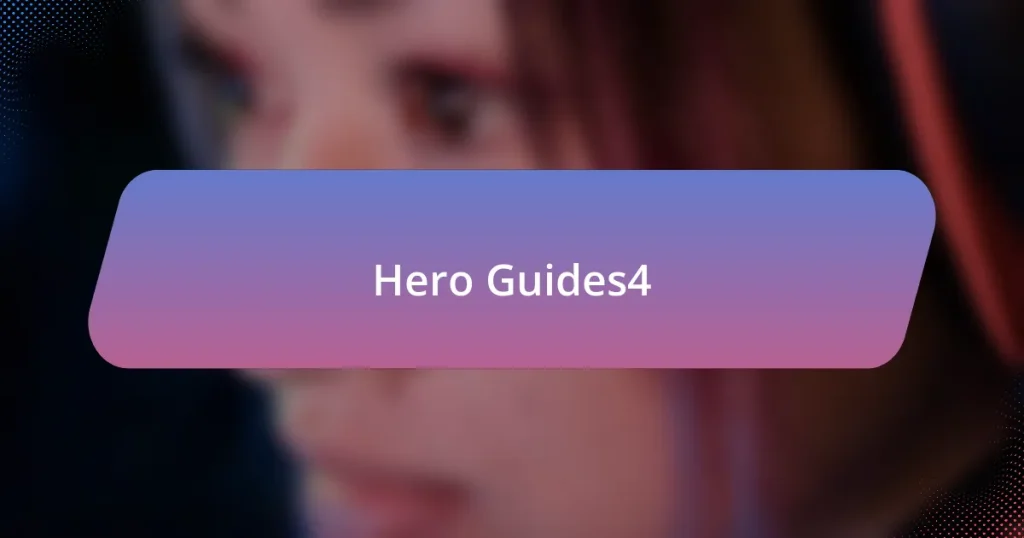Carry heroes in Dota 2 are specialized characters that excel in dealing damage and scaling into the late game, becoming powerful assets as they accumulate gold and experience. This article explores the defining characteristics of carry heroes, their differences from other roles, and their importance in team compositions and game outcomes. It details the stages of a carry hero’s development, strategies for effective play, and common mistakes to avoid. Additionally, the article emphasizes the significance of early game farming, positioning, and decision-making in maximizing a carry hero’s potential and impact on the match.

What are Carry Heroes in Dota 2?
Carry heroes in Dota 2 are characters designed to deal significant damage and scale well into the late game. They typically start the game weaker than other heroes but become powerful as they accumulate gold and experience, allowing them to purchase items that enhance their damage output and survivability. Carry heroes often rely on farming resources efficiently and require protection from teammates during the early stages of the game to reach their full potential. Their role is crucial in team fights, as they can turn the tide of battle with their high damage capabilities once they are adequately equipped.
How do Carry Heroes differ from other hero roles?
Carry heroes differ from other hero roles primarily in their focus on scaling power and damage output as the game progresses. Unlike support or tank roles, which prioritize utility and survivability, carry heroes are designed to become stronger in the late game, often relying on accumulating gold and experience to maximize their potential. This is evidenced by their ability to deal significant damage and secure kills, especially in the late stages of a match, where they can turn the tide of battle. Carry heroes typically require a safe farming period early in the game to build essential items, which distinguishes their gameplay strategy from other roles that may engage more actively in team fights or map control from the outset.
What defines a hero as a Carry in Dota 2?
A hero is defined as a Carry in Dota 2 primarily by its ability to scale in power throughout the game, particularly in the late game, where it can deal significant damage and secure kills. Carry heroes typically possess high damage output, strong scaling abilities, and the potential to carry the team to victory through their item progression. For instance, heroes like Anti-Mage and Phantom Assassin exemplify this role as they become increasingly powerful with items, allowing them to dominate opponents in the later stages of the match.
What are the key characteristics of Carry Heroes?
Carry Heroes in Dota 2 are characterized by their ability to scale effectively into the late game, high damage output, and reliance on farm to reach their full potential. These heroes typically have abilities that enhance their damage or survivability, allowing them to become formidable threats as the game progresses. For instance, heroes like Anti-Mage and Phantom Assassin exemplify this with their high agility growth and powerful late-game abilities, making them capable of dealing significant damage to enemy heroes and structures. Additionally, Carry Heroes often require a supportive team to secure farm and protect them during the early to mid-game, emphasizing their dependency on both resources and team dynamics to succeed.
Why are Carry Heroes important in a Dota 2 match?
Carry heroes are important in a Dota 2 match because they are primarily responsible for dealing significant damage in the late game, which is crucial for securing victories. Their ability to scale with items allows them to become powerful forces that can turn the tide of battles, especially during critical moments such as team fights and pushing objectives. Statistically, games often hinge on the performance of carry heroes, as they typically contribute the highest damage output and are essential for taking down enemy structures. This role is vital for transitioning from the mid-game to the late game, where their impact can determine the outcome of the match.
How do Carry Heroes influence the game’s outcome?
Carry heroes significantly influence the game’s outcome by scaling in power during the late game, allowing them to deal substantial damage and secure objectives. Their ability to farm efficiently and accumulate gold and experience enables them to outscale opponents, often leading to decisive team fights and pushing strategies. For instance, in professional Dota 2 matches, carry heroes like Anti-Mage or Spectre often dictate the pace of the game by forcing enemy teams to respond to their threats, which can lead to advantageous positioning and map control. This dynamic is supported by statistics showing that games where a carry hero reaches their core items often result in higher win rates, demonstrating their critical role in determining the final outcome.
What role do Carry Heroes play in team composition?
Carry Heroes serve as the primary damage dealers in team compositions, focusing on scaling in power throughout the game. Their role is to accumulate resources, such as gold and experience, to become stronger in the late game, often leading to victory through high damage output. In Dota 2, Carry Heroes typically occupy the safe lane, where they can farm efficiently and gain levels while being protected by teammates. This strategic positioning allows them to transition into powerful late-game assets capable of turning the tide of battles.
What are the stages of a Carry Hero’s development?
The stages of a Carry Hero’s development in Dota 2 are early game, mid game, and late game. In the early game, the Carry focuses on farming gold and experience while avoiding unnecessary confrontations. During the mid game, the Carry begins to participate in team fights and objectives, leveraging their accumulated resources to secure kills and push lanes. In the late game, the Carry becomes the primary damage dealer for the team, relying on their items and levels to secure victory in crucial engagements. This progression is essential for maximizing the Carry’s potential and effectiveness throughout the match.
What is the significance of the early game for Carry Heroes?
The early game is crucial for Carry Heroes as it sets the foundation for their scaling potential and overall impact in the match. During this phase, Carry Heroes focus on farming efficiently to accumulate gold and experience, which are essential for acquiring key items that enhance their damage output and survivability. For instance, a well-farmed Carry can secure critical items like Battle Fury or Black King Bar by the mid-game, allowing them to transition into a dominant force in team fights. Additionally, securing early kills or assists can provide valuable gold and momentum, further accelerating their item progression. Thus, the early game significantly influences a Carry Hero’s effectiveness and ability to carry the team to victory later in the match.
How do Carry Heroes transition from mid to late game?
Carry heroes transition from mid to late game by focusing on farming efficiently, securing key items, and participating in team fights strategically. During the mid game, carry heroes prioritize last-hitting creeps and neutral camps to accumulate gold and experience, which is essential for item progression. They aim to acquire core items like Battle Fury or Black King Bar, which enhance their damage output and survivability.
As they approach the late game, carry heroes shift their focus to team fights, utilizing their items to deal significant damage while positioning themselves safely. They often rely on their team to initiate fights, allowing them to capitalize on their damage potential without being at risk. This transition is crucial, as successful execution can lead to securing objectives like towers and Roshan, ultimately contributing to victory.
How do players effectively utilize Carry Heroes?
Players effectively utilize Carry Heroes by focusing on farming efficiently, positioning strategically, and timing their engagements. Farming efficiently allows Carry Heroes to accumulate gold and experience quickly, enabling them to purchase essential items that enhance their damage output and survivability. Strategic positioning during team fights ensures that Carry Heroes can deal damage while minimizing the risk of being targeted by enemy heroes. Timing engagements is crucial; players must recognize when to join fights based on their item progression and the state of the game, ensuring they contribute maximally to team success. These practices are supported by the game’s mechanics, where Carry Heroes typically scale better into the late game, making their effective utilization vital for securing victories.
What strategies should players adopt when playing Carry Heroes?
Players should focus on farming efficiently and positioning strategically when playing Carry Heroes. Efficient farming involves maximizing gold and experience gain by last-hitting creeps and utilizing jungle camps, which is crucial for scaling into the late game. Strategic positioning is essential during team fights, as Carry Heroes typically deal high damage but are vulnerable to being targeted. Maintaining a safe distance while dealing damage allows them to contribute effectively without being eliminated early in engagements. Additionally, players should prioritize itemization that enhances their damage output and survivability, such as acquiring damage-boosting items and defensive gear. This approach ensures that Carry Heroes can fulfill their role of leading the team to victory in the later stages of the game.
How can players maximize their farm and item progression?
Players can maximize their farm and item progression by efficiently managing their resources and optimizing their gameplay strategies. Focusing on last-hitting creeps increases gold income, while prioritizing lane control and map awareness allows players to secure additional farm opportunities. Utilizing items that enhance farming speed, such as Battle Fury or Maelstrom, further accelerates item progression. Additionally, taking advantage of jungle camps and stacking them can provide significant boosts to gold and experience. Studies show that players who consistently practice these strategies can see a marked improvement in their overall performance and item acquisition rates in Dota 2.
What are the common mistakes to avoid when playing Carry Heroes?
Common mistakes to avoid when playing Carry Heroes include overextending without vision, neglecting farm efficiency, and failing to prioritize itemization. Overextending without vision can lead to unnecessary deaths, as Carry Heroes are often targeted by enemy ganks. Neglecting farm efficiency results in slower progression, which is critical for Carry Heroes to scale into the late game. Failing to prioritize itemization can hinder their effectiveness in fights; for instance, not acquiring key items like Black King Bar or Manta Style can leave them vulnerable to crowd control and burst damage. These mistakes can significantly impact the overall performance and success of the Carry role in Dota 2.
How can poor positioning affect a Carry Hero’s performance?
Poor positioning significantly hampers a Carry Hero’s performance by exposing them to unnecessary damage and reducing their effectiveness in team fights. When a Carry Hero is poorly positioned, they may become an easy target for enemy initiators or crowd control abilities, leading to quick elimination before they can deal damage. This vulnerability can result in lost opportunities to secure kills or objectives, ultimately impacting the team’s overall success. In competitive play, statistics show that Carry Heroes with higher survivability often have a greater impact on the game’s outcome, highlighting the importance of strategic positioning in maximizing their potential.
What are the pitfalls of over-farming as a Carry?
Over-farming as a Carry can lead to several pitfalls, primarily including a lack of team support and vulnerability to enemy ganks. When a Carry focuses excessively on farming, they may neglect their role in team fights, resulting in missed opportunities to contribute to objectives or assist teammates. This behavior can create an imbalance where the Carry becomes isolated, making them an easy target for opponents who can capitalize on their absence from team engagements. Additionally, over-farming can delay item progression for the entire team, as resources are not being shared effectively, which can hinder overall team performance. In competitive play, this strategy often leads to a loss of map control and increased pressure from the enemy team, ultimately jeopardizing the chances of winning the game.
What are the best practices for mastering Carry Heroes?
To master Carry Heroes in Dota 2, players should focus on last-hitting creeps, positioning, and itemization. Last-hitting is crucial as it maximizes gold income, allowing for faster item progression, which is essential for a Carry’s effectiveness in the late game. Proper positioning during team fights ensures that the Carry can deal damage while remaining safe from enemy threats, which is vital for survival and impact. Additionally, understanding itemization is key; selecting the right items based on the game state and enemy composition can significantly enhance a Carry’s performance. For example, items like Battle Fury increase farming efficiency, while Black King Bar provides necessary survivability in fights. These practices are supported by the game’s mechanics and strategies, emphasizing the importance of execution in mastering Carry Heroes.
How can players improve their decision-making as a Carry?
Players can improve their decision-making as a Carry by enhancing their map awareness and understanding game dynamics. This involves consistently checking the minimap to track enemy movements and assessing the positioning of allies, which allows for timely responses to threats and opportunities. Additionally, players should analyze their item builds and adapt them based on the game state, ensuring they maximize their effectiveness in fights. For instance, choosing items that counter specific enemy heroes can significantly influence the outcome of engagements. Furthermore, practicing last-hitting and farming efficiently increases gold and experience, enabling carries to scale effectively into the late game. Studies show that players who focus on these aspects tend to have higher win rates, as they make more informed decisions that align with the overall strategy of their team.
What resources are available for learning about Carry Heroes?
To learn about Carry Heroes in Dota 2, players can utilize various resources including official Dota 2 guides, community forums, and video tutorials. The Dota 2 website offers comprehensive hero guides that detail the abilities, strengths, and strategies for each Carry Hero. Additionally, platforms like YouTube feature numerous content creators who provide gameplay analysis and tips specifically for Carry roles. Websites such as Dotabuff and Liquipedia also provide statistics and insights into hero performance, helping players understand the meta and optimal builds for Carry Heroes.
How can players adapt their Carry Hero choices based on the game situation?
Players can adapt their Carry Hero choices based on the game situation by assessing factors such as team composition, enemy heroes, and the current state of the game. For instance, if the opposing team has strong crowd control or burst damage, players may opt for a Carry Hero with built-in survivability or escape mechanisms, like Anti-Mage or Phantom Lancer. Conversely, if the team requires more damage output against tanky opponents, selecting heroes like Medusa or Terrorblade can be beneficial. Additionally, players should consider their own team’s needs; if the team lacks initiation, choosing a Carry that can also provide crowd control, such as Faceless Void, can enhance overall effectiveness. This strategic flexibility is crucial for maximizing the Carry’s impact throughout the match.
What factors should influence the selection of a Carry Hero in a match?
The selection of a Carry Hero in a match should be influenced by the hero’s scaling potential, team composition, and the enemy lineup. Carry Heroes are typically chosen based on their ability to deal significant damage in the late game, which is determined by their scaling potential, such as how well they benefit from items and levels. Team composition is crucial, as a Carry Hero must synergize with support and offlane heroes to create effective strategies, while also considering the need for crowd control and initiation. Additionally, the enemy lineup must be analyzed to select a Carry that can effectively counter opposing heroes, ensuring survivability and damage output. For instance, if the enemy has a lot of physical damage, a Carry with high armor or evasion may be preferred.
How do team compositions affect Carry Hero effectiveness?
Team compositions significantly impact Carry Hero effectiveness by determining the synergy and support available to the Carry throughout the game. A well-structured team composition that includes heroes providing crowd control, healing, or initiation enhances the Carry’s ability to farm efficiently and engage in team fights. For instance, a composition with strong frontline tanks and crowd control allows the Carry to deal damage safely, while a lack of support can lead to vulnerability and reduced impact in fights. Studies show that teams with balanced compositions, including a dedicated support role, have higher win rates, as they enable the Carry to scale effectively into the late game and maximize their potential.











